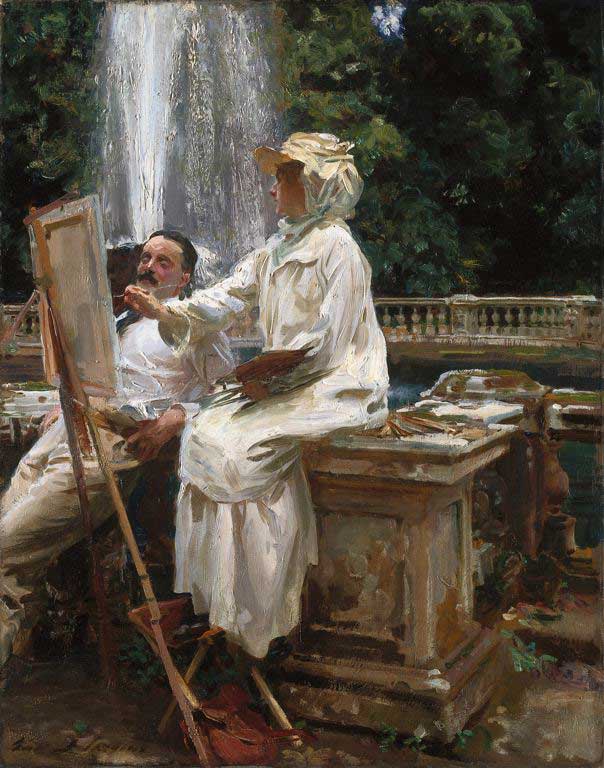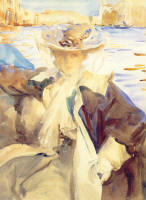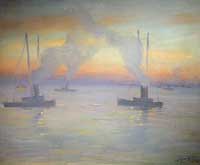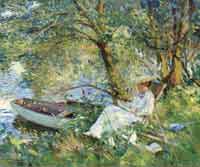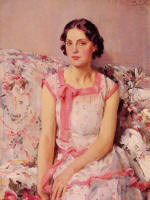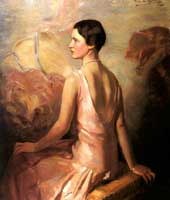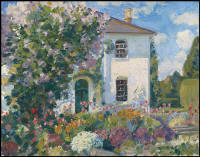The
Fountain, Villa Torlonia, Frascati, Italy
John
Singer Sargent
-- American painter
1907
Art
Institute of Chicago, Illinois
Oil on
canvas
72.4 x
55.9 cm (28 1/2
x 22 in.)
Signed,
lower left: "John S. Sargent"
Friends of American Art Collection, 1914.57
Jpg: Local / ArtInstituteofChicago
(Click on
image to Step
Closer)
Jane de Glehn
(1873-1961) painting
with her husband Wilfrid (1870-1951) at the Fountain at Villa Torlonia
in Frascati, Italy.
Wilfrid
de Glehn
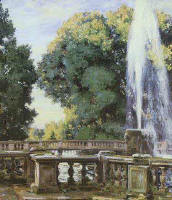
Fountain
Frascati
1907
Married in 1904,
both were often
traveling companions of John's between 1905 and 1914 when they all
would
visit such places as the south of France, Spain, places in Italy --
Venice
and the Alps. Both were accomplished painters in their own right, and
all
three depicted each other often in their paintings on these trips.
Jane wrote in a
letter to a friend;
"He [Sargent] has struck Wilfred in
looking
at my sketch with rather a contemptuous expression as much as to say
'Can
you do plain sewing any better?'.........Wilfried is in shirt sleeves,
very idle and good for nothing and our heads come against the great
panache
of the fountain."
John had actually
met them separately
and although maybe not directly, he played an overall magnetic
force
to the two which brought them together.
Jane Erin Emmet
de Glehn (1873-1961)
Jane was born Jane
Erin Emmet. An
American of Irish decent, her father could trace the family back
to the same family of the “Bold” Robert Emmet. She
was
also a cousin of the novelist Henry James.
Jane was the youngest of three very talented sisters, all who
became
artists of some note: Rosina Emmet Sherwood (1854-1948), Lydia Field
Emmet
(1866-1952), and then Jane (1873-1961).
Jane's education
followed the proven
path of her older siblings --- studying at New York’s Art Students
League
first before traveling through Europe to see the paintings of the Grand
Masters and then further training in Parisian ateliers. The first two
sisters
moved back to New York and worked under William
Merritt Chase at his 10th Street Studio and became involved with
his
ground-breaking art school at Shinnecock, Long Island.
The exact itinerary
of the three
with dates is yet unclear to me, but Jane was significantly younger (19
years separated her to the oldest sister, and 7 years between her
middle
sister). She would have found herself in New York on the first leg of
her
journey after her older sisters were well established.
Through her sisters
or possibly as
a student at the New York’s Art Students League, she met Sargent as
late
as 1890 when she was only 17. I can clearly put her in attendance at
party
given by Sargent at Chases' 10th street studio that year when John
hired Carmencita to perform by
bringing to life
his famous painting of El Jaleo.
Wilfrid Gabriel
de Glehn (1870-1951)
Wilfreid de Glehn,
on the other hand,
an Englishman born at Sydenham, London, first met John at Morgan
Hall, after Edwin Austin
Abbey
hired him, along with another student, to assist the two artists in
their
joint Boston Public
Library
mural projects.
Wilfred had
recently completed his
studies at the Ecole
des Beaux Art in Paris which had followed studies at the South
Kensington
School of Art (c.1889). It was a chance for him to apprentice
directly
under two active artists. Though his work was really more with Abbey
than
Sargent, they all worked in close proximity and the friendship formed
between
Wilfred and John would prove to be close and lasting. Wilfred arrived
at
Morgan Hall in the latter part of '90 or early 91 and work on the
murals
would last until 1893.
Wilfred would
exhibit his own work
first in Rome in 1894 and then in Paris the following year ('95) when
he
also became Associetaire of the Société des Artistes
Français.
His first showing at Royal Acadame followed in '96. By 1900 he joined
the NEAC.
His first visit to
Cornwall came
in 1901.
When Wilfrid Met
Jane
When he first met
his wife is still
a little vague to me. Some sources put Wilfred in Boston in 1903 (after
helping Sargent on in his Boston mural instillation of that year).
Other
sources, I think more creditable, put Jane in London visiting friends.
In either case, the
two were married
the following year (1904) and honeymooned in Cornwall, later visiting
Paris
and Venice. The two took residence in London. Because of medical
reasons
Jane was unable to have children so the two adopted a nomadic lifestyle
traveling extensively between 1905 and 1914 -- accompanying Sargent on
his trips throughout Europe, and when he wasn't with them, on their own
through America.
When the war
brought an end to that
way of life, the two joined the British Red Cross staff, in France, in
1915. On their return to England the following year he was commissioned
in the Artists’ Rifles and seconded to the Front in Italy in 1917.
Born Wilfrid Von
Glehn, the two changed
their name to De Glehn in 1917 following the lead of the British Royal
family which shed it Germanic roots as a result of the war.
After the war they
returned to England
and Wilfred held a solo exhibition at the Leicester Galleries and
another
solo show in New York in 1920. For the next decade the two would spend
summers in Cornwall and winters in France.
Wilfred was elected
ARA in 1923 and
RA in 1932. The family moved to Wiltshire
in 1942 where he died in 1951.
Wilfrid de Glehn is
one of the few
English Impressionists. Jane, apparently, didn't publicly exhibit her
work
-- that I can tell -- but the two undoubtedly were strongly
influenced
by John Singer Sargent's style. They were the personification of that
Anglo-American
art circle which floated around Sargent and the two were friends with
painters Frank
D. Millet and J. Alden Weir, architects Stanford White and Charles
McKim, the collector Isabella
Stewart
Gardner, and the novelist Edith Wharton.
From:
john debruyne
jde bruyne_ anst
eyhall@yahoo.co.uk
Date: Sat, 16 Oct 2004
My great uncle was Wilfred de Glehn but may I first add my
admiration for your website? What a treat and what an important
repository and unlike all the coffee- table books it is
alive and growing.
I am writing a book on my family and I am very keen to find
out more but I have no proprietorial feeling
about any of my biographical
information, and as you requested, here is a start:
Wilfred Gabriel de Glehn's father, my great grandfather,
was Alexander von Glehn -- one of twelve children of Robert von Glehn.
A
rather romantic Baltic German baron. My girlfriend who lives in San
Francisco and I visited the von Glehn castle just outside Tallin in
Estonia this summer. The uncle Nikolai von Glehn was a manic sculptor
in the mold of Gaudi. One of Robert's other sons was Oswald von Glehn a
high Victorian classical painter and friend of Rosetti etc.
In spite of the German name of Alexander von Glehn's four
grand parents three were Scottish. I have a portrait by Henry Raeburn
of Robert von Glehn's mother-in-law who was a miss Melville.
When I was
a child I used to sit beside "Uncle Willie" and watch him paint. I
exasperated him by being chiefly interested in how I should sign my
name at the bottom of the picture which I did before I put any paint
down. And he talked to me as if I were an adult. He had no children of
his own which is how I ended up with much of his studio and his
letters.
Sargent always called him
Premp and (this is dangerous territory) I think he was possibly
romantically keen on his young protégé. When Willie
married Jane Emmet he sulked for some months and only finally gave him
a wedding present (A secretaire antique desk with a Lowestoft china
dining set which I still have) some six months after the wedding.
Eventually he came to value Jane who was a capable American matriarch
of the type he appreciated. He liked tough women.
Just like
Henry James who was a friend and cousin of Jane's so my late mother
also knew Sargent well. She looked after him when he was elderly and
visited Cornwall. One conversation she had was how much she loved
Sargent's Frascati fountain picture [which you have above]. Sargent
replied, "Yes I know I should have given it to Will and Jane but I
didn't think at the time that they liked it very much." The odd pose of
Willie lounging beside Jane was an afterthought. "Stay there Premp.You
look like her gigalo, I'll paint you in." Uncle Willie said it was
agony after a while because the stone balustrade cut into his back.
I have the
picture of the fountain that Willie was painting. We have
many of the stereo photographs which Sargent took on his travels. I
also have a lovely portrait of my late mother which won a prize at the
RA for Willie.
One story
about that was that during the sitting at the studio,
Sargent dropped by to take Willie out to
lunch. "It is so hard to get the likeness
when it is of your own family," Willie complained.
Sargent looked hard at the portrait. "Elma has one eye
higher than the other. Look... . " He took the palette and repainted
one
lower. "There...now can we go to lunch?"
When my mother turned up at Colnagi
the Bond Street
dealers to see her painting the doorman
said "Elma, do come in." She was startled being only seventeen.
"How do you know me?" she enquired. "I recognized you, of
course!" Just inside the door her portrait was being shown on an easel
stand.
Hope some of the above is of interest.
John de Bruyne
Notes:
Exhibitions
John
Singer
Sargent,
An Exhibition -- Whitney
Museum, NY & The Art Institute of Chicago 1986-1987
1) Robert Emmet
(1778-1803)
helped plan and lead an uprising in Dublin in 1803. Forced to act early
because of an explosion at one of the arms depots, the uprising
disintegrated
into chaos. Wearing a green and white uniform Emmet and a small troop
marched
on Dublin Castle, killing the Lord Chief Justice on the way. He fled,
hoping
to escape to America with his fiancé Sarah Curran. He was
captured
and hung.
At his trial Emmet
requested that
no epitaph be written for him until Ireland took her place among the
nations
of the earth.
(web)

|

